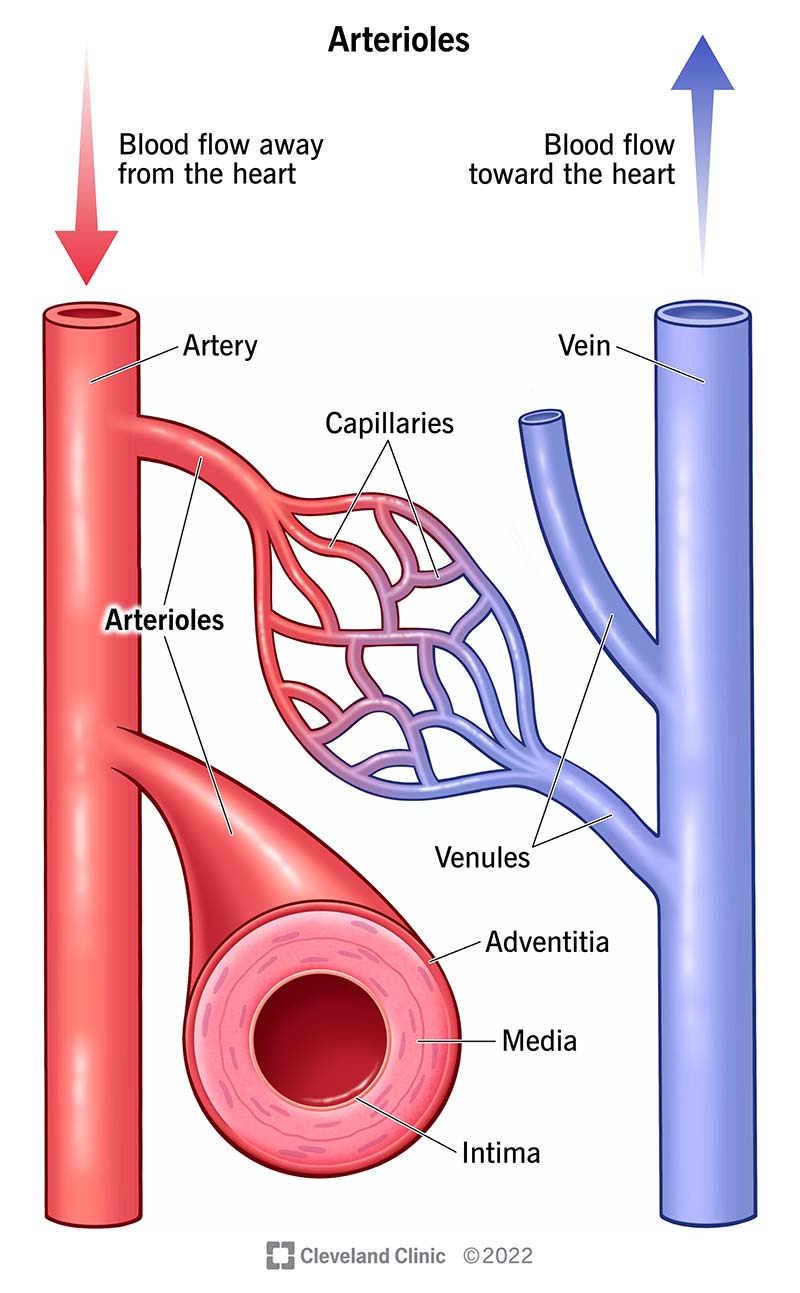Arterioles, small blood vessels that carry blood away from your heart, are connectors between your arteries and capillaries. They control your blood pressure and blood flow throughout your body, using their muscles to change their diameter. They also link to capillaries to exchange oxygen, nutrients and waste.

An arteriole (är-‘tir-ē-,ōl) is a very small blood vessel that branches off from your artery and carries blood away from your heart to your tissues and organs.
Arterioles are small arteries that link up to capillaries, which are smaller yet. With their very thin walls, your capillaries act like an exchange station where oxygen and nutrients trade places with waste from your tissues. Your smallest veins (venules), which take blood back to your heart, also link to your capillaries to make these exchanges.
Cleveland Clinic is a non-profit academic medical center. Advertising on our site helps support our mission. We do not endorse non-Cleveland Clinic products or services. Policy
Your small but powerful arterioles control blood flow and blood pressure throughout your body.
Since your arterioles are located all throughout your body, they can help any of your organs. Here are some examples.
Instead of sharing neurons (nerve cells), each smooth muscle cell in an arteriole has its own neuron that receives signals to expand or contract the size of the arteriole. That means each muscle cell has a direct line of communication when your nervous system sends a request to make arterioles’ diameter bigger or smaller to adjust blood pressure or flow.
When your arteriole makes its diameter half of what it was, that cuts the blood flow down to one-sixteenth of what it was.
Since arterioles are involved in getting oxygen and nutrients to your cells and tissue, they’re located all throughout your body.
Arterioles are 100 μm (micrometers or microns) to 7 μm (or .30 to .01 millimeters) in diameter. Arteriole walls are .02 millimeters thick.
Arterioles are tubes with thick walls of muscle that can adjust the amount of space they have inside. This allows them to keep your blood pressure at a certain level and control how much blood flows through your arterioles.
They’re more muscular than veins because they have to be able to handle higher blood pressure when your heart pumps blood out to your body and have to be able to contract and dilate more forcefully to adjust blood flow.
Arterioles have three layers:
Since arterioles are blood vessels, conditions that affect the cardiovascular system also affect arterioles. Conditions affecting your arterioles include:
Damage to arteriole walls makes them less able to dilate or constrict. This affects both blood pressure and blood flow.
Symptoms of some conditions that affect arterioles include:
Your healthcare provider can use the following imaging methods to check arterioles:
Your healthcare provider may prescribe medicines that help your cardiovascular system — which includes your arterioles — work better. These include:
You can help keep your arterioles healthy with these habits:
A note from Cleveland Clinic
You may not think about your tiny, hard-working arterioles, but they’re important for managing your body’s blood flow and blood pressure. You can keep your entire cardiovascular system at its best when you eat healthy foods and get regular physical activity. Since some cardiovascular problems don’t have symptoms early on, it’s a good idea to get regular checkups with your healthcare provider. They can catch issues before they become larger problems.
Last reviewed by a Cleveland Clinic medical professional on 06/25/2022.
Learn more about our editorial process.
Cleveland Clinic is a non-profit academic medical center. Advertising on our site helps support our mission. We do not endorse non-Cleveland Clinic products or services. Policy